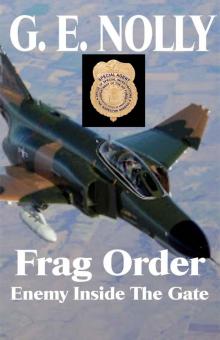- Home
- G. E. Nolly
Radiant Crossing
Radiant Crossing Read online
Radiant Crossing
Trouble On Black Friday
G. E. Nolly
This book is a work of fiction. Names, characters, places and incidents are either the product of the author's imagination or are used fictionally. Any resemblance to actual persons, living or dead, or to actual events or locales is entirely coincidental.
Copyright 2012 by G. E. Nolly
Version 2013.11.08
This book is dedicated to American military veterans, past, present, and future.
This book is a work of fiction. Names, characters, places and incidents are either the product of the author's imagination or are used fictionally. Any resemblance to actual persons, living or dead, or to actual events or locales is entirely coincidental.
This ebook is licensed for your personal enjoyment only. This ebook may not be re-sold or given away to other people. If you like to share this book with another person, please purchase an additional copy for each person you share it with.
Copyright © 2013 G. E. Nolly. All rights reserved. Including the right to reproduce this book or portions thereof, in any form. No part of this text may be reproduced in any form without the express written permission of the author.
Version 2013.03.16
This book is dedicated to American military veterans, past, present, and future.
1
November 28, 2013
2013 Greenwich Mean Time
West 30 Degrees
Flight Level 310
I had just drifted off to sleep, with the rhythmic undulations of the aircraft gently rocking me to sleep, when there was a loud knock on the bunk door. Calling the claustrophobic space a bunk was a stretch, but at least it provided the opportunity to get a power nap while my two copilots manned the cockpit. I opened the door and swung my legs to the aisle floor, being careful not to completely sit up so I wouldn’t hit my head on the bottom of the upper bunk.
I blinked against the light in the narrow hallway between the passenger cabin and the cockpit as I let my eyes adjust. Bill Burton, our Purser, was standing in the hallway.
“Captain Hancock, the crew called me to wake you. You’re needed in the cockpit immediately.”
“Thanks, Bill. Could you please send up a coffee, black with Splenda?”
“Right away, sir.”
My mind raced to clear the cobwebs as I tried to envision what the problem was. I could fully appreciate what the Captain of Air France 447 must have experienced, as he was awakened from his crew rest and rushed to the cockpit as his airplane was falling out of the sky. Two minutes later, he was dead, along with everyone else on his plane.
But this was different. Unlike Air France 447, we were operating in daylight hours. At night, every emergency is at least twice as difficult to handle. More important, we were in a Boeing 777, not the Airbus 340 that Air France 447 flew. Every time I thought of 447, I muttered to myself, “If it ain’t Boeing, I ain’t going”.
I entered the cockpit access code into the keypad on the door lock and waited for the crew to unlock the fortified door. Mary, the First Class Flight Attendant, had arrived behind me with a Styrofoam cup of coffee. I took a quick sip, and the fog instantly started to clear from my mind. Obviously, my degree of sleepiness or wakefulness was totally psychological.
Jim Johnson, the copilot assigned to the left seat, peered through the viewport and opened the door. I swiftly entered.
“What’s up, guys?”
“Sir, we’re having a lot of different problems,” said Mark Mason, my other copilot. “They all happened at the same time, about ten minutes ago. And they all seem unrelated.”
“Okay,” I replied, “let’s go over them one by one. What’s the most serious?”
“ Well,” Jim answered, “we lost our GPS positioning. Both of them.”
That was unusual. Really unusual. The 777 has enough redundancy in its systems that if one component fails, another will pick up the slack. I’d been flying the 777 for over ten years, and never had a Global Position System fail. The odds against both failing were astronomical.
But it wasn’t that big a deal, really. The Flight Management Computers on the airplane would simply compute our present position, groundspeed and wind vector from the Inertial Reference Units. The IRUs were much more accurate than the Inertial Navigation Systems like we had in the older airplanes. An INS will get you position accuracy within a few miles after a 10-hour flight like ours, while an IRU will get you within a hundred feet. And once we were over land, instead of the middle of the Atlantic Ocean where we presently were, the FMC would use land-based navigation transmitters, VORs, to update our position.
My copilots were too young to remember when we didn’t have “glass” cockpits, with moving-map displays and GPS positioning. During our layover in London, when we’d been doing some “hangar flying” at the hotel bar, they’d confided to me that they’d never flown anything but glass. Even their basic flight training airplanes had glass instruments. Using old-fashion round dials, like I’d been flying with for most of my forty-year career, would be an emergency procedure for them.
“Okay,” I responded, “not that big a problem. What else?”
“ At 30 west we couldn’t get CPDLC to work, and we’ve been unable to raise Gander on either HF or VHF.”
“Did you try the left, right and center radios for both VHF and HF?” I asked.
“Yes,sir,” Jim responded,. “tried them all. Nothing.”
That could be a problem, but not a show-stopper. The Controller-Pilot Data Link Communications System was the airborne equivalent of sending emails back and forth between aircraft and Air Traffic Control. CPDLC made it much easier to talk to ATC than trying to make contact on the radio through static and interference from other aircraft transmissions. Our fallback communications method would be what we used back in the old days – voice transmissions on the radio, using either HF or VHF. It was really unusual for both radio systems, with their triple redundancy, to be inoperative.
Fortunately, the weather was severe clear. I looked ahead and could see an Air Canada 767 a thousand feet below us, slightly ahead, our speeds perfectly matched. Well ahead I could see contrails, those white trails that form when an aircraft disturbs the air and causes ice crystals to form, that indicated where we would be flying next. All aircraft on North Atlantic routes, called NAT Tracks, flew on assigned flight paths at specifically-assigned speeds. There were additional tracks every thirty miles north and south of our route.
I could see the other aircraft on our Traffic Collision and Avoidance System, called TCAS, and everyone seemed to be on course with no problems.
“Have you tried 12345?” I asked.
“Not yet,” Jim answered, “We thought we’d get your input before we went outside our airplane.”
That was a good call. It could have been something as simple as a couple of popped circuit breakers, and there was no reason to tell the world yet. I instinctively glanced at the overhead circuit breaker panel. None were tripped. I moved my transmitter selector to the right VHF radio, which was tuned to the oceanic inter-plane frequency of 123.45 megahertz.
“This is WorldJet Airways 407 on 12345. Is anybody up on frequency?”
“Hello, WorldJet Airways, this is Air Canada 332, a bit past 30 west. We’re having problems contacting Gander on any of their frequencies, and we’ve lost our GPS. And our SATCOM isn’t working also. Are you having the same problems?”
“That’s affirmative,” I answered, “We have no comm with our company on ACARS also.”
The Arinc Communication and Reporting System was an automatic data link with our company headquarters. Theoretically, we could maintain communications with our company anywhere in the world with either ACARS
or the Satellite Communications system. When Air Canada mentioned SATCOM, Mark pointed at the Satellite Communications control panel and gave me a thumbs down signal.
“Same here.”
“WorldJet Airways and Air Canada, this is Delta 883. We’re about sixty miles ahead of you. Did you hear US Air’s transmission?”
“Delta, this is WorldJet Airways 407. Negative. Would you relay for us?”
“Roger, WorldJet Airways. US Air said that the word is being passed along that there’s been an EMP attack. No one is in contact with ATC, and we’re all pretty much on our own.”
An Electro Magnetic Pulse attack, the detonation of a nuclear weapon at high altitude over the United Airways States, could wipe out the entire power grid of the country in the blink of an eye. There’d been stories about the Iranians planning something like that, and the subject had been in the news recently when Boeing had announced that they had developed a drone that could do the same thing to

 Radiant Crossing
Radiant Crossing Radiant Crossing: Trouble On Black Friday (The Adventures of Hamilton Hamfist Hancock Book 5)
Radiant Crossing: Trouble On Black Friday (The Adventures of Hamilton Hamfist Hancock Book 5) Hamfist Out: The Chill Is Gone (The Air Combat Adventures of Hamilton Hamfist Hancock Book 4)
Hamfist Out: The Chill Is Gone (The Air Combat Adventures of Hamilton Hamfist Hancock Book 4) Frag Order: Enemy Inside The Gate
Frag Order: Enemy Inside The Gate Hamfist Over Hanoi: Wolfpack on the Prowl (The Air Combat Adventures of Hamilton Hamfist Hancock Book 4)
Hamfist Over Hanoi: Wolfpack on the Prowl (The Air Combat Adventures of Hamilton Hamfist Hancock Book 4)